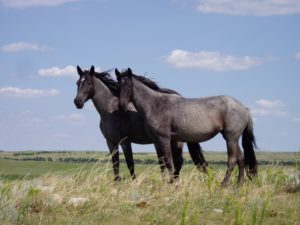Equine Anemia
Horses, like humans, can be anemic. Anemia is influenced by the amount of red blood cells circulating in a horse’s bloodstream. The average horse has a packed cell volume (PCV) of 40%. While this percentage varies depending on a horse’s fitness levels, a horse is deemed anemic when their PCV is less than 30%. Anemia is typically caused by either blood loss, blood destruction, or reduced blood cell production. Once a horse is classified as anemic, a vet will need to determine why the horse’s body is not producing enough red blood cells or where the red blood cells are going. Some cases of anemia are acute which others are chronic.
Impacts of Low Red Blood Cells
Red blood cells are important because they contain hemoglobin. Hemoglobin delivers oxygen to the tissues of the body through the circulatory system. Lack of hemoglobin damages the tissues. There are a few common causes of anemia, which include:
-
Traumatic injury/hemorrhaging
-
Internal Parasites
-
Toxic Plants (red maple leaves, etc.)
-
Ulcers (tendency to slowly bleed)
-
Nutritional Deficiencies
-
Iron Deficiencies
There are other causes of anemia. Some causes are less common than others, yet each scenario is different. The symptoms of anemia vary by the cause as well. Horses with iron deficiencies will appear vastly different than a horse with internal parasites. Those horses that have chronic anemia must receive periodic blood test to ensure that their blood levels are balanced. As always, it is important to remain in contact with your vet and constantly seek their advice.
By Anna Hellman
-
Articles
- October 2024
- September 2024
- August 2024
- July 2024
- June 2024
- May 2024
- April 2024
- March 2024
- February 2024
- January 2024
- December 2023
- November 2023
- October 2023
- September 2023
- August 2023
- July 2023
- June 2023
- May 2023
- April 2023
- March 2023
- February 2023
- December 2022
- November 2022
- October 2022
- September 2022
- August 2022
- July 2022
- June 2022
- May 2022
- April 2022
- March 2022
- February 2022
- January 2022
- December 2021
- November 2021
- October 2021
- September 2021
- August 2021
- July 2021
- May 2021
- April 2021
- March 2021
- February 2021
- January 2021
- December 2020
- November 2020
- October 2020
- September 2020
- August 2020
- July 2020
- June 2020
- May 2020
- April 2020
- March 2020
- February 2020
- January 2020
- December 2019
- November 2019
- October 2019
- September 2019
- August 2019
- July 2019
- June 2019
- May 2019
- April 2019
- March 2019
- February 2019
- January 2019
- December 2018
- November 2018
- October 2018
- September 2018
- August 2018
- July 2018
- June 2018
- May 2018
- April 2018
- March 2018
- February 2018
- January 2018
- November 2017
- October 2017
- September 2017
- August 2017
- July 2017
- June 2017
- May 2017
- April 2017
- March 2017
- February 2017
- January 2017
- December 2016
- October 2016
- September 2016
- August 2016
- July 2016
- June 2016
- May 2016
- April 2016
- March 2016
- February 2016
- January 2016
- December 2015
- November 2015
- October 2015
- August 2015
- June 2015
- May 2015
- March 2015
- November 2014
- March 2014
- October 2013
- September 2013
- August 2013
- January 2013
- December 2012
- November 2012
- October 2012
- September 2012
- January 2012
- October 2011
- September 2011
- August 2011
- July 2011
- June 2011
- February 2011
-
Meta






